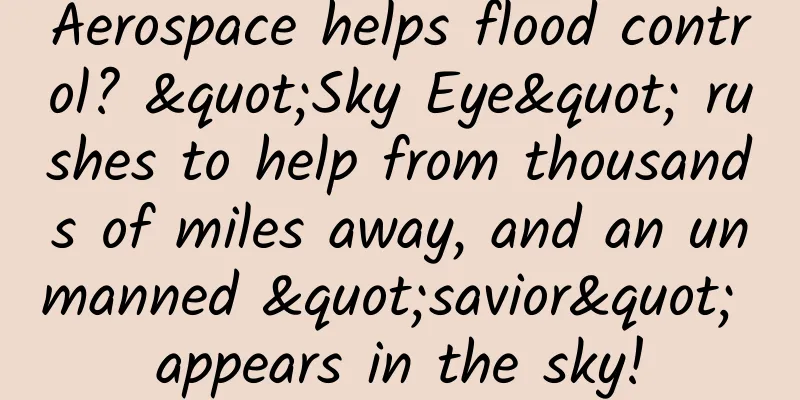Aerospace helps flood control? "Sky Eye" rushes to help from thousands of miles away, and an unmanned "savior" appears in the sky!

|
Recently, due to extreme weather such as heavy rainfall and typhoons, floods have occurred in many parts of my country. Faced with the rather severe flood prevention and control situation, what contributions can my country's growing aerospace force make? What aerospace technology principles are reflected behind it? "Sky Eye" rushes to help from thousands of miles away In 2018, my country formally established the Ministry of Emergency Management, and its National Disaster Reduction Center is responsible for providing various technical support for disaster prevention and reduction, emergency rescue operations, including satellite remote sensing, which is increasingly used. With the continuous improvement of satellite remote sensing, relevant departments can monitor and collect important data in a timely manner, and issue early warnings before disasters break out on a large scale and safety hazards emerge, so as to protect the lives and property of the people to the greatest extent. my country's remote sensing satellites provide timely images of disaster areas For example, during the summer flood season of 2020, Gaofen-3, my country's first C-band multi-polarization synthetic aperture radar satellite with a resolution of 1 meter, monitored and analyzed flood disasters in the Poyang Lake area around the clock. By analyzing the images taken by the satellite, ground personnel were able to promptly understand the expansion speed and status of the water area of Poyang Lake. After image analysis and data aggregation, ground personnel fully understood the situation in the disaster-stricken areas, so as to more specifically coordinate the emergency rescue forces of all parties and carry out disaster relief and mitigation work efficiently. In addition, satellite remote sensing technology can also help ground personnel monitor images and collect ground information over a large area, determine the location of high-risk dikes, and speed up the progress of risk elimination. In the event of a dike breach or other dangerous situation, remote sensing satellites can dynamically monitor the location, extent, and impact range of the dike breach, help count the disaster situation, and provide assistance for the deployment of emergency forces. After the flood, ground personnel must continue to use satellite remote sensing technology for detailed monitoring and further verify grassroots disaster information. In similar disaster rescue operations in many places in Hunan this year, remote sensing satellites provided high-definition images and key data in the first time in accidents caused by mountain torrents on some sections of the Yakang Expressway in Sichuan, which caused vehicles to fall and people to lose contact, to assist in search and rescue work. As the technology level of domestic remote sensing satellites continues to improve and their deployment and networking become more and more complete, relevant forces have rushed to overseas to help neighboring countries and regions monitor and warn of major natural disasters. The effectiveness of satellite remote sensing technology is inseparable from the strong support of the Beidou satellite navigation system. According to public data, my country's traditional water situation monitoring methods are relatively simple, mainly using contact water situation monitoring methods to monitor water levels and flows. They lack the ability to timely monitor sudden mountain torrents caused by heavy rainfall and rivers with limited water level and flow relationship curve data. Moreover, the distribution of monitoring stations is uneven, and information delays are inevitable in remote areas with poor network communication conditions, which may cause serious consequences. In order to meet the needs of national security, social and economic development, my country has independently developed the BeiDou global satellite navigation system. The BeiDou system not only seamlessly covers the entire land area of my country and the surrounding sea areas, but also provides global users with all-weather, all-day, high-precision positioning, navigation and timing services. Other value-added services have also made significant contributions to the national flood prevention and disaster reduction work. For example, the high-precision positioning function of the Beidou system has played a significant role in the field of reservoir and dam safety monitoring. The system first uses the Beidou base station, Beidou monitoring station seepage meter, seepage pressure meter and other sensors to collect data in real time, and then uses the network to transmit the monitoring data to the reservoir monitoring center for summary and collation, realizing all-weather monitoring of the seepage pressure, seepage, displacement and settlement of the reservoir section. Correspondingly, high-precision positioning technology can also be applied to other geological disaster monitoring and early warning. In 2020, Shimen County, Hunan Province installed the Beidou satellite high-precision geological disaster monitoring and early warning system at the Leijiashan geological disaster risk point, and monitored various geological and hydrological information in real time through 11 monitoring points. The system has issued orange geological disaster warnings for many consecutive times, helping surrounding villagers to quickly evacuate and successfully avoid large-scale landslides. Communications "takes on the task in times of crisis" After constructing hydrological telemetry stations in rivers, lakes, reservoirs, channels, groundwater and other water bodies, sensors such as rain gauges, water level gauges and current meters can automatically collect information such as rainfall, water level and flow rate, and automatically report the data to the monitoring center in real time, provided that communication is smooth. There are many communication channels commonly used for hydrological data transmission, but the area must be covered by a stable communication network. The Beidou satellite navigation system can serve as a backup emergency communication channel for hydrological telemetry stations in areas where the ground communication network is poor. In addition, the Beidou short message communication service has a single communication capacity of up to 1,000 Chinese characters in my country and surrounding areas, and 40 Chinese characters worldwide, which basically meets the needs of the hydrological measurement and reporting field. For example, during the summer flood season of 2020, the main channel of the automatic monitoring and reporting system of the Shipai Hydrological Station in Anqing City, Anhui Province was once abnormal, resulting in the interruption of water level information transmission. The Beidou system had to "relay" to ensure that water information was uploaded in a timely manner. However, if a typhoon causes severe floods or geological disasters, the communication systems in some areas are likely to be unstable or interrupted. At this time, portable satellite base stations will be "called upon to help" rescue workers build a "lifeline" as soon as possible. Portable satellite base stations play a key role in flood prevention and disaster relief At present, the portable satellite base station used by my country's communication engineers for emergency rescue has a total weight of only 13.5 kg and can be put into a backpack after being folded. After simple operation, communication engineers can easily set up a base station with automatic satellite alignment. This type of satellite base station generally has its own large-capacity battery and WiFi function. It can restore mobile network connection within 3 minutes, support more than 30 people to talk at the same time, and provide emergency network protection for 2.5 hours. It is particularly suitable for emergency communication occasions under extreme conditions such as circuit breakage, network disconnection, and power outage. With the popularization of Tiantong satellite applications, the direct mobile phone call function has also become very popular, playing an important role in communicating and coordinating emergency and post-disaster work and stabilizing the emotions of people in disaster-stricken areas. Both satellite base stations and satellite phones require hardware support, which is where high-throughput satellites come in. Compared with traditional satellites, high-throughput satellites have better signal strength and communication speed, and can not only support basic calls, but also effectively guarantee video communication and Internet access for on-site personnel. No one "savior" is in the sky After all, satellite support for disaster rescue is affected by revisit cycles and atmospheric interference. In rescue missions with smaller scopes and higher timeliness requirements, drones often play a greater role. my country once dispatched an unmanned helicopter equipped with a high-throughput satellite network phased array terminal, which achieved continuous 6-hour 5G signal coverage in an area of 80 square kilometers and provided network services to 2,400 users. In fact, the UAVs developed by my country's aerospace units are technologically advanced and diverse, with distinctive features such as flexibility, rapid response, convenient operation, and diverse functions, and are widely used in various complex rescue missions. In addition to supporting network communications, UAVs also play an important role in disaster detection. Drones perform emergency mapping missions In the past, after flood disasters occurred, rescue workers relied more on manned aircraft and speedboats, which had more restrictions on the timing and passability of dispatch. Today, drones can be equipped with detection systems, and can be dispatched more efficiently and frequently, and obtain valuable information on the front line of disaster relief. More importantly, drones are relatively cheap to use, portable and easy to use. Rescuers can fly multiple drones at the same time or "borrow power" to fly drones for a long time, use visible light, infrared and other detection payloads, shoot real-time video data of the disaster area, collect 3D modeling data, provide refined 3D models, and quickly transmit them back to the disaster relief headquarters, providing effective technical support for the formulation of scientific and reasonable disaster relief plans. Affected by the flood, some trapped people cannot be evacuated immediately. At this time, drones can give full play to their flexible and maneuverable advantages to deliver daily necessities and rescue equipment in a timely manner. For example, when floods break bridges and block communications between the two sides, rescuers can use drones to deliver traction ropes to the other side, assist in setting up a crossing system, and establish a transportation channel for life supplies. Specially modified emergency rescue drones use a fully automatic positioning system, and the operator only needs to input the coordinates of the delivery point, environmental maps, etc., to automatically perform the delivery mission. During flood and mudslide disasters in mountainous areas, drones can take advantage of their strong wind resistance, excellent stability and low noise to provide emergency lighting and other services at resettlement sites. They only need to be equipped with a high-power light source and connected to the ground with wires to have almost "unlimited flight time", becoming the "brightest star in the night sky" and helping to resettle people. In addition, drones have been widely used in rescue assistance, search and rescue assistance, emergency surveying and mapping and other fields. It can be said that they provide all-round technical support for flood control and disaster relief. In fact, in my country's flood disaster relief operations, various types of satellites, mobile communication facilities, drones and other aerospace technology products have achieved coordinated cooperation and complementary advantages. As the performance of aerospace products continues to improve and their applications become more extensive, it is believed that my country's disaster relief and reduction operations will become more efficient and convenient, further reducing the loss of life and property of the people. (Author: Lin Yinzhi. Image sources: China Resources Satellite Application Center, China Unicom Huhao, and Aerospace Rainbow UAV Co., Ltd.; Review expert: Jia Yang, researcher of the General Department of China Academy of Space Technology) |
<<: Are you stressed? The puppy passing by also cares | Nature Trumpet
>>: This "ancestor" of the square city was the first to pioneer the central axis!
Recommend
Are male genes disappearing? New research reveals the genetic mystery of human Y chromosomes...
The Y chromosome is the true root of a man becaus...
If the whole of China was a class, Guizhou would be the classmate who secretly played PlayerUnknown's Battlegrounds!
Mixed Knowledge Specially designed to cure confus...
The moon is the most familiar and mysterious object. How should ordinary people observe it?
Author | Wang Siliang Review | Zheng Chengzhuo Ed...
Tips for opening an account and promoting Baidu bidding in Guangzhou
How to promote new accounts is a question that ma...
Don’t ignore “visibility” when promoting product fission
Whether it is an Internet product or a consumer p...
From ancient Greece, the "intoxicating journey" of beer begins...
A handful of lamb skewers, a plate of edamame, an...
Community Operation | Master these 3 steps to make your community "live"
Most people who run communities have experienced ...
Wuwei teacher main line capture dragon (02 issue) September
Wuwei teacher's main line of catching dragons...
The inventor of copy and paste has passed away. 50 years ago, she laid the foundation for the basic functions of Word
Evelyn Berezin, the grandmother who invented “cop...
Medical and health institutions have achieved full coverage of counties, towns and villages! How is it achieved specifically? Details attached!
On May 24, 2022, the National Health Commission h...
Stones that look like leeches after heating may sound scary, but they are actually a great help in building construction →
Yu Feng Recently, the State Council issued the &q...
Toutiao’s 40-page data report comprehensively analyzes content entrepreneurship!
Over the past year or so, the rising star-like ex...
Do “sleep-aiding foods” really help you sleep?
This is the 4373rd article of Da Yi Xiao Hu Sleep...
What are you doing when you should be sleeping?
"What are you doing when you should be sleep...









